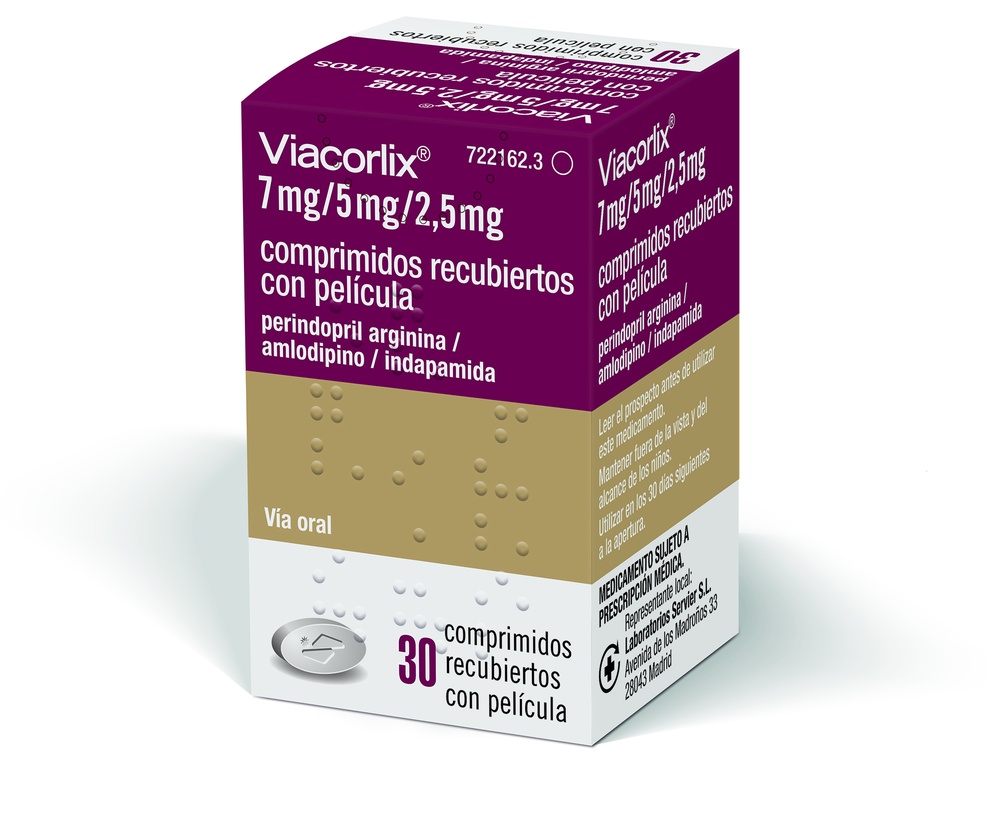

VIACORLIX 7 MG/5 MG/2.5 MG FILM-COATED TABLETS

Ask a doctor about a prescription for VIACORLIX 7 MG/5 MG/2.5 MG FILM-COATED TABLETS

How to use VIACORLIX 7 MG/5 MG/2.5 MG FILM-COATED TABLETS
Introduction
Leaflet:information for the user
Viacorlix7mg/5mg/2.5mg film-coated tablets
perindopril arginine/amlodipine/indapamide
Read the entire leaflet carefully before starting to take this medication, as it contains important information for you.
- Keep this leaflet, as you may need to read it again.
- If you have any questions, consult your doctor or pharmacist.
- This medication has been prescribed to you only, and you should not give it to others, even if they have the same symptoms as you, as it may harm them.
- If you experience side effects, consult your doctor or pharmacist, even if they are not listed in this leaflet. See section 4.
Contents of the leaflet
- What is Viacorlix and what is it used for
- What you need to know before taking Viacorlix
- How to take Viacorlix
- Possible side effects
5 Conservation of Viacorlix
- Package contents and additional information
1. What is Viacorlix and what is it used for
Viacorlix is an association of three active substances: perindopril, amlodipine, and indapamide. Viacorlix is an antihypertensive medication used to treat high blood pressure in adults.
Patients who are already taking perindopril/amlodipine as a fixed-dose combination and indapamide in separate tablets may take instead one Viacorlix tablet containing the three active substances at the same doses.
Each of the active substances lowers blood pressure, and all act together to control your blood pressure:
- Perindopril belongs to a group of medications called ACE inhibitors (Angiotensin-Converting Enzyme). It works by widening blood vessels, making it easier for your heart to pump blood through them.
- Amlodipine is a calcium channel blocker (belonging to a group of medications called dihydropyridines). It works by relaxing blood vessels, allowing blood to pass through them easily.
- Indapamide is a diuretic (belonging to a group of medications called sulfamoyl derivatives with an indole ring). Diuretics increase the amount of urine produced by the kidneys. However, indapamide is different from other diuretics, as it only produces a slight increase in the amount of urine formed.
2. What you need to know before taking Viacorlix
Do not take Viacorlix if:
- you are allergic (hypersensitive) to perindopril or any other ACE inhibitor, amlodipine or any other calcium antagonist, and indapamide or any other sulfonamide or any of the other components of this medication (listed in section 6),
- you have severe kidney disease,
- you are undergoing dialysis or any other type of blood filtration. Depending on the machine used, Viacorlix may not be suitable for you,
- you have kidney problems that reduce the amount of blood reaching your kidneys (renal artery stenosis),
- you have taken or are currently taking sacubitril/valsartan, a medication for heart failure, as it increases the risk of angioedema (rapid swelling under the skin in an area such as the throat) (see "Warnings and precautions" and "Using Viacorlix with other medications"),
- you have severe liver disease or suffer from a condition called hepatic encephalopathy (liver problems affecting the brain and central nervous system),
- you have low potassium levels in your blood,
- you have experienced symptoms such as wheezing, facial or tongue swelling, intense itching, or severe skin rashes with previous treatment with ACE inhibitors, or if you or a family member has had these symptoms in any other circumstance (a disorder called angioedema),
- you are pregnant over 3 months (it is also best to avoid Viacorlix during the start of pregnancy - see section Pregnancy),
- you have very low blood pressure (hypotension),
- you have a narrowing of the aortic valve in your heart (aortic stenosis) or cardiogenic shock (a condition where the heart is unable to pump enough blood to the body),
- you suffer from heart failure after a heart attack,
- you have diabetes or impaired kidney function and are being treated with a blood pressure-lowering medication containing aliskiren.
Warnings and precautions
Consult your doctor or pharmacist before starting to take Viacorlix if you:
- have had photosensitivity reactions,
- have hypertrophic cardiomyopathy (a disease of the heart muscle),
- have heart failure or heart rhythm problems,
- have severe high blood pressure (hypertensive crises),
- have any other heart problems,
- have liver problems,
- have kidney problems (including kidney transplant),
- experience a decrease in vision or eye pain. These could be symptoms of fluid accumulation in the vascular layer of the eye (choroidal effusion) or increased pressure in your eye, and can occur within hours to weeks after taking Viacorlix. If left untreated, this can lead to permanent vision loss. If you have previously had an allergy to penicillin or sulfonamides, you may be at higher risk of developing this,
- have muscle disorders, including muscle pain, sensitivity, weakness, or cramps,
- have abnormally high levels of a hormone called aldosterone in your blood (primary aldosteronism),
- have a vascular disease of the collagen (a disease of the connective tissue) such as systemic lupus erythematosus or scleroderma,
- have diabetes,
- are following a low-salt diet or are using salt substitutes that contain potassium (it is essential to have a balanced potassium level in the blood),
- are an elderly patient,
- are taking any of the following medications used to treat high blood pressure:
- an "angiotensin II receptor antagonist" (ARA) (also known as sartans - e.g., valsartan, telmisartan, irbesartan), especially if you have kidney problems related to diabetes.
- aliskiren.
Your doctor may monitor your kidney function, blood pressure, and electrolyte levels (such as potassium) in your blood periodically. See also the information under the heading "Do not take Viacorlix".
- you are of black African descent, as you may be at higher risk of angioedema, and this medication may be less effective in lowering your blood pressure than in patients who are not of black African descent.
- you have gout,
- you need to undergo a test to check that your parathyroid gland is working properly,
- you are taking any of the following medications, as the risk of angioedema is higher:
- racecadotril (used to treat diarrhea),
- sirolimus, everolimus, temsirolimus, and other medications belonging to the class of mTor inhibitors (used to prevent organ rejection and for cancer),
- sacubitril (available as a fixed-dose combination with valsartan), used to treat long-term heart failure,
- linagliptin, saxagliptin, sitagliptin, vildagliptin, and other medications belonging to the class of gliptins (used to treat diabetes).
Angioedema:
In patients treated with ACE inhibitors, including perindopril, angioedema (severe allergic reaction with swelling of the face, lips, tongue, or throat with difficulty swallowing or breathing) has been reported. This can occur at any time during treatment. If you develop these symptoms, you should stop taking Viacorlix and see your doctor immediately. See also Section 4.
You should inform your doctor if you think you are (or might become) pregnant. Viacorlix is not recommended at the start of pregnancy and should not be taken after the third month of pregnancy, as it may cause serious harm to your baby if used during this period (see sections "Pregnancy" and "Breastfeeding").
When taking Viacorlix, you should inform your doctor or healthcare professional if you:
- are going to undergo general anesthesia and/or major surgery,
- have recently suffered from diarrhea or vomiting,
- are going to receive desensitization treatment to reduce allergic reactions to bee or wasp stings,
- are going to undergo a medical test that requires the injection of an iodinated contrast agent (a substance that allows organs such as the kidney or stomach to be visible with X-rays).
Your doctor may recommend that you have blood tests to check for low sodium or potassium levels or high calcium levels.
Athletes should be aware that Viacorlix contains an active substance (indapamide) that may give a positive result in a doping test.
Children and adolescents
Viacorlix should not be given to children or adolescents.
Taking Viacorlix with other medications
Tell your doctor or pharmacist if you are taking, have recently taken, or might take any other medication.
You should avoid taking Viacorlix with:
- lithium (used to treat mania or depression),
- estrMustine (used to treat cancer),
- potassium-sparing medications (e.g., triamterene, amiloride), potassium supplements, or salt substitutes that contain potassium, other medications that may increase potassium levels in your body (such as heparin, a medication used to thin the blood and prevent clots; trimethoprim and cotrimoxazole, also known as trimethoprim/sulfamethoxazole, for bacterial infections),
- aliskiren (used to treat high blood pressure), (see also the information under the heading "Do not take Viacorlix" and "Warnings and precautions"),
- angiotensin II receptor antagonists (ARAs) (used to treat high blood pressure) (e.g., valsartan, telmisartan, irbesartan...),
- dantrolene (perfusion) (used to treat muscle stiffness in diseases such as multiple sclerosis or to treat malignant hyperthermia during anesthesia, including symptoms such as high fever and muscle stiffness),
- medications commonly used to treat diarrhea (racecadotril) or to prevent organ rejection (sirolimus, everolimus, temsirolimus, and other medications belonging to the class of mTor inhibitors). See section "Warnings and precautions",
- sacubitril/valsartan (used to treat long-term heart failure). See sections "Do not take Viacorlix" and "Warnings and precautions".
Treatment with Viacorlix may be affected by other medications. Make sure to inform your doctor if you are taking any of the following medications, as you may need special care:
- other medications for high blood pressure, including diuretics (medications that increase the amount of urine produced by the kidneys) and ACE inhibitors (used to treat high blood pressure and heart failure),
- medications for heart rhythm disorders (e.g., quinidine, hydroquinidine, disopyramide, amiodarone, sotalol, ibutilide, dofetilide, cardiac glycosides, bretylium),
- procainamide (for the treatment of irregular heart rhythm),
- ephedrine, noradrenaline, or adrenaline (medications used to treat low blood pressure, shock, or asthma),
- medications used to treat mental problems such as depression, anxiety, schizophrenia, etc. (e.g., tricyclic antidepressants, antipsychotics, imipramine-type antidepressants, neuroleptics (such as amisulpride, sulpiride, sultoprida, tiaprida, haloperidol, droperidol)),
- antibiotics used to treat bacterial infections (e.g., rifampicin, erythromycin injection, clarithromycin, esparfloxacin, moxifloxacin),
- bepridil (used to treat angina pectoris, a condition that causes chest pain),
- cisapride (used to treat reduced movement of the esophagus and stomach),
- difemanil (used to treat gastrointestinal problems such as ulcers, too much acid, or an overactive digestive system),
- vincamine injection (used to treat cognitive disorders in elderly patients, including memory loss),
- halofantrine (an antiparasitic medication used to treat certain types of malaria),
- pentamidine (used to treat certain types of pneumonia),
- antihistamines used to treat allergic reactions, such as hay fever (e.g., mizolastine, astemizole, terfenadine),
- antifungal medications (e.g., itraconazole, ketoconazole, amphotericin B injection),
- tetracosactide (for the treatment of Crohn's disease),
- stimulant laxatives,
- medications for the treatment of diabetes (such as insulin, gliptins, metformin),
- baclofen used to treat muscle stiffness in diseases such as multiple sclerosis,
- potassium-sparing medications used in the treatment of heart failure: eplerenone and spironolactone at doses between 12.5 mg and 50 mg per day; amiloride, triamterene,
- non-steroidal anti-inflammatory medications (e.g., ibuprofen) to relieve pain or high doses of acetylsalicylic acid, a substance present in many medications used to relieve pain and reduce fever, as well as to prevent blood clotting,
- Hypericum perforatum(St. John's Wort, a medicinal plant used to treat depression),
- vasodilators, including nitrates (medications that dilate blood vessels),
- corticosteroids (used to treat various disorders, including severe asthma and rheumatoid arthritis),
- alpha blockers used to treat prostate enlargement, such as prazosin, alfuzosin, doxazosin, tamsulosin, terazosin,
- amifostine (used to prevent or reduce the side effects caused by other medications or by radiation therapy used to treat cancer),
- ritonavir, indinavir, nelfinavir (also known as protease inhibitors used to treat HIV),
- gold salts, especially when given intravenously (used to treat rheumatoid arthritis),
- iodinated contrast medium (used for X-ray tests),
- calcium tablets or other calcium supplements,
- immunosuppressants (medications that reduce the body's defense mechanisms) used to treat autoimmune disorders or after a transplant (e.g., cyclosporine, tacrolimus),
- allopurinol (for the treatment of gout),
- antiepileptic medications such as carbamazepine, phenobarbital, phenytoin, fosphenytoin, primidone,
- trimethoprim (for the treatment of infections),
- methadone (used to treat addictions).
Taking Viacorlix with food and drinks
See section 3.
People taking Viacorlix should not consume grapefruit juice or grapefruit. This is because grapefruit and grapefruit juice can lead to an increase in the levels of the active ingredient amlodipine in the blood, which can cause an unpredictable increase in the blood pressure-lowering effect of Viacorlix.
Pregnancy and breastfeeding
If you are pregnant or breastfeeding, think you may be pregnant, or plan to become pregnant, consult your doctor or pharmacist before using this medication.
Pregnancy
You should inform your doctor if you think you are (or might become) pregnant.
Your doctor will generally advise you to stop taking Viacorlix before becoming pregnant or as soon as you know you are pregnant and will advise you to take another medication instead of Viacorlix. Viacorlix is not recommended at the start of pregnancy and should not be taken after the third month of pregnancy, as it may cause serious harm to your baby if used during this period.
Breastfeeding
Amlodipine has been shown to pass into breast milk in small amounts. Inform your doctor if you are breastfeeding or plan to start breastfeeding. Viacorlix is not recommended for breastfeeding mothers, and your doctor may choose another treatment for you if you want to breastfeed your child, especially if your baby is newborn or premature.
Driving and using machines
Viacorlix may affect your ability to drive or use machines. If the tablets make you feel sick, dizzy, weak, or tired, or give you a headache, do not drive or use machinery and consult your doctor immediately.
Viacorlix contains sodium
This medication contains less than 1 mmol of sodium (23 mg) per film-coated tablet, so it is considered essentially "sodium-free".
3. How to take Viacorlix
Follow the administration instructions for this medication exactly as indicated by your doctor. If in doubt, consult your doctor or pharmacist again.
The recommended dose is one Viacorlix tablet once a day.
Take the tablet preferably at the same time each day, in the morning and before breakfast.
Do not exceed the prescribed dose.
If you take more Viacorlix than you should
If you take too many tablets, contact your doctor immediately or go to the emergency department of your nearest hospital.
In case of overdose or accidental ingestion, consult the Toxicological Information Service, phone 91 562 04 20, indicating the medication and the amount taken.
The most frequent symptom in case of overdose is a decrease in blood pressure that can cause dizziness or fainting. If this occurs, lying down with your legs raised may help.
It can cause nausea (feeling of dizziness), vomiting, cramps, drowsiness, confusion, and changes in the amount of urine produced by the kidneys.
You may feel dizzy, lightheaded, or weak. If the drop in your blood pressure is severe enough, you may suffer from shock. You may feel your skin cold and wet, and you may lose consciousness.
Excess fluid may accumulate in the lungs (pulmonary edema) causing difficulty breathing, which can develop up to 24-48 hours after ingestion.
If you forget to take Viacorlix
It is essential to take this medication every day, as continuous treatment works better. However, if you forget to take a dose of Viacorlix, take the next dose at the usual time. Do not take a double dose to make up for the forgotten dose.
If you interrupt treatment with Viacorlix
Since treatment with Viacorlix is usually for life, you should talk to your doctor before stopping this medication.
If you have any other questions about using this medication, ask your doctor or pharmacist.
4. Possible side effects
Like all medications, this medication can cause side effects, although not everyone will experience them.
Stoptreatment with this medication andgoimmediately to your doctor if you experience any of the following side effects that may besevere:
- sudden whistling when breathing, chest pain, shortness of breath, or difficulty breathing (bronchospasm) (uncommon - may affect up to 1 in 100 people),
- swelling of the eyelids, face, or lips (uncommon - may affect up to 1 in 100 people),
- swelling of the mouth, tongue, and throat, which causes great difficulty breathing (angioedema) (uncommon - may affect up to 1 in 100 people),
- severe skin reactions including intense skin rash, hives, redness of the skin all over the body, intense itching (erythema multiforme) (very rare - may affect up to 1 in 10,000 people), blistering, peeling, and inflammation of the skin (exfoliative dermatitis) (very rare - may affect up to 1 in 10,000 people), inflammation of the mucous membranes (Stevens-Johnson syndrome) (very rare - may affect up to 1 in 10,000 people), or other allergic reactions (common - may affect up to 1 in 10 people), toxic epidermal necrolysis (frequency not known - frequency cannot be estimated from available data),
- severe dizziness or fainting (common - may affect up to 1 in 10 people),
- weakness in arms or legs or speech problems that could be a sign of a possible stroke (very rare - may affect up to 1 in 10,000 people),
- heart attack, chest pain (angina) (very rare - may affect up to 1 in 10,000 people), abnormally fast or irregular heartbeat (common - may affect up to 1 in 10 people),
- inflammation of the pancreas that can cause intense abdominal and back pain accompanied by a great feeling of discomfort (very rare - may affect up to 1 in 10,000 people),
- yellowing of the skin or eyes (jaundice) that could be a sign of hepatitis (very rare - may affect up to 1 in 10,000 people),
- brain disease caused by liver disease (hepatic encephalopathy) (frequency not known),
- muscle weakness, cramps, sensitivity, or muscle pain, and especially if you feel unwell or have a high temperature, as they can be caused by abnormal muscle breakdown (frequency not known).
In decreasing order of frequency, side effects may include:
- Very common (may affect more than 1 in 10 people):
Edema (fluid retention).
- Common (may affect up to 1 in 10 people):
Low potassium levels in the blood, headache, numbness or tingling in the limbs, drowsiness (especially at the beginning of treatment), taste disorders, vision disorders (including double vision), tinnitus (ringing in the ears), vertigo, palpitations (feeling heartbeats), flushing, dizziness, cough, difficulty breathing (dyspnea), abdominal pain, constipation, diarrhea, dyspepsia, or difficulty digesting, nausea, vomiting, alteration of bowel habits, pruritus, allergic reactions such as skin rashes, itching, redness of the skin, muscle cramps, swelling of the ankles (edema), feeling of fatigue, weakness.
- Uncommon (may affect up to 1 in 100 people):
Rhinitis (congested or runny nose), increase in the number of some white blood cells (eosinophilia), low blood sugar levels (hypoglycemia), high potassium levels in the blood that can cause an abnormal heart rhythm (hyperkalemia), low sodium levels in the blood (hyponatremia) that can cause dehydration and low blood pressure, insomnia, mood changes, anxiety, depression, sleep disorders, loss of pain sensation, tremors, fainting, vasculitis (inflammation of blood vessels), dry mouth, hair loss, red spots on the skin (purpura), skin discoloration, increased sweating, photosensitivity reaction (changes in skin appearance) after exposure to sun or artificial UVA rays, formation of blisters on the skin, muscle or joint pain, back pain, urination disorders, increased need to urinate at night, increased frequency of urination, kidney problems, impotence (inability to have or maintain an erection), discomfort or enlargement of the breasts in men, chest pain, pain, feeling of discomfort, fever, elevated blood urea, elevated creatinine in the blood, fall.
- Rare (may affect up to 1 in 1,000 people):
Low chloride levels in the blood, low magnesium levels in the blood, confusion, worsening of psoriasis, high bilirubin levels in the blood, increased liver enzyme levels, decreased or absent diuresis, acute kidney failure.
Concentrated urine, feeling of discomfort (nausea) or being sick (vomiting), muscle cramps, confusion, and convulsions. These symptoms can be part of a disease called SIADH (inadequate secretion of antidiuretic hormone).
- Very rare (may affect up to 1 in 10,000 people):
Changes in blood parameters such as decreased white and red blood cell count, decreased hemoglobin concentration, decreased platelet count, high blood sugar levels (hyperglycemia), high calcium levels in the blood (hypercalcemia), increased muscle tension, nerve disorder that can cause weakness, eosinophilic pneumonia (a rare type of pneumonia), gum inflammation, abdominal swelling (gastritis), yellowing of the skin (jaundice), acute kidney failure.
If you experience these symptoms, contact your doctor as soon as possible.
- Frequency not known (cannot be estimated from available data):
Short-sightedness (myopia), blurred vision, decreased vision, or eye pain due to high pressure (possible signs of fluid accumulation in the vascular layer of the eye (choroidal effusion) or acute angle-closure glaucoma), if you have systemic lupus erythematosus (a type of collagen disease), it may worsen, abnormal electrocardiogram, tremors, postural rigidity, facial rigidity similar to a mask, slow movements, and imbalance in gait with foot drag, increased uric acid, a substance that can cause or worsen gout (joint pain, especially in the feet), color change, numbness, and pain in the fingers or toes (Raynaud's disease).
Reporting side effects
If you experience any side effects, consult your doctor or pharmacist, even if they are possible side effects not listed in this leaflet. You can also report them directly through the Spanish Medicines Surveillance System for Human Use: www.notificaRAM.es. By reporting side effects, you can help provide more information on the safety of this medication.
5. Storage of Viacorlix
Keep this medication out of sight and reach of children.
Do not use this medication after the expiration date shown on the box and bottle after EXP. The expiration date is the last day of the month indicated.
This medication does not require special storage conditions.
Once opened, Viacorlix should be used within the following 10 days for 10-tablet bottles, 30 days for 30-tablet bottles, and 100 days for 100-tablet bottles.
Medicines should not be disposed of through wastewater or household waste. Deposit the packaging and unused medicines in the pharmacy's SIGRE collection point. If in doubt, ask your pharmacist how to dispose of the packaging and medicines you no longer need. This will help protect the environment.
6. Package contents and additional information
Viacorlix composition
- The active ingredients are perindopril arginine, amlodipine, and indapamide.
One Viacorlix 7 mg/5 mg/2.5 mg film-coated tablet contains 4.75 mg of perindopril equivalent to 7 mg of perindopril arginine, 6.935 mg of amlodipine besylate equivalent to 5 mg of amlodipine, and 2.5 mg of indapamide.
- Other ingredients are:
- Core: calcium carbonate starch 90%, pregelatinized corn starch 10%, microcrystalline cellulose (E460), sodium croscarmellose (E468), magnesium stearate (E470b), anhydrous colloidal silica, pregelatinized corn starch.
- Coating: glycerol (E422), hypromellose 6cP (E464), macrogol 6000, magnesium stearate (E470b), titanium dioxide (E171).
Appearance of the product and package contents
Viacorlix is a white, elongated film-coated tablet measuring 11.5 mm in length and 6.09 mm in width, engraved with on one of its faces.
Viacorlix tablets are available in packs of 10, 30, 60 (2 bottles of 30 tablets), 90 (3 bottles of 30 tablets), or 100 film-coated tablets.
For the 10, 30, 60, and 90 tablet formats, the desiccant is located in the cap of the tablet bottle.
For the 100-tablet format, the desiccant is located in the screw cap of the bottle.
Not all pack sizes may be marketed.
Marketing authorization holder and manufacturer
Marketing authorization holder:
Les Laboratoires Servier
50, rue Carnot
92284 Suresnes cedex
France
Manufacturer:
Servier (Ireland) Industries Ltd.
Gorey Road
Arklow - Co. Wicklow – Ireland
or
Les Laboratoires Servier Industrie
905, route de Saran
45520 Gidy
France
or
EGIS Pharmaceuticals PLC
H-9900 Körmend, Mátyás király u.65
Hungary
or
Anpharm Przedsiebiorstwo Farmaceutyczne S.A.
03-236 Warszawa, ul. Annopol 6b
Poland
You can request more information about this medication by contacting the local representative of the marketing authorization holder:
Laboratorios Servier S.L.
Avenida de los Madroños 33
28043 Madrid
This medication is authorized in the Member States of the European Economic Area under the following names:
France | Tricorlix 7 mg/5 mg/2.5 mg, film-coated tablet |
Germany | Viacorind 7 mg/5 mg/2.5 mg film-coated tablets |
Latvia | Tricorlix 7 mg/5 mg/2.5 mg film-coated tablets |
Netherlands | Tricorlix 7 mg/5 mg/2.5 mg film-coated tablets |
Romania | Viacorlix 7 mg/5 mg/2.5 mg film-coated tablets |
Spain | Viacorlix 7 mg/5 mg/2.5 mg film-coated tablets |
Date of the last revision of this leaflet: November 2022
Detailed information about this medication is available on the website of the Spanish Agency for Medicines and Health Products (AEMPS) (http://www.aemps.gob.es/).

How much does VIACORLIX 7 MG/5 MG/2.5 MG FILM-COATED TABLETS cost in Spain ( 2025)?
The average price of VIACORLIX 7 MG/5 MG/2.5 MG FILM-COATED TABLETS in December, 2025 is around 24.67 EUR. Prices may vary depending on the region, pharmacy, and whether a prescription is required. Always check with a local pharmacy or online source for the most accurate information.
- Country of registration
- Average pharmacy price24.67 EUR
- Active substance
- Prescription requiredYes
- Manufacturer
- This information is for reference only and does not constitute medical advice. Always consult a licensed doctor before taking any medication. Oladoctor is not responsible for medical decisions based on this content.
- Alternatives to VIACORLIX 7 MG/5 MG/2.5 MG FILM-COATED TABLETSDosage form: TABLET, 7 mg/5 mg/2.5 mgActive substance: perindopril, amlodipine and indapamideManufacturer: Krka D.D. Novo MestoPrescription requiredDosage form: CAPSULE, 10 mg/10 mgActive substance: ramipril and bisoprololManufacturer: Adamed Laboratorios S.L.U.Prescription requiredDosage form: CAPSULE, 10 mg/5 mgActive substance: ramipril and bisoprololManufacturer: Adamed Laboratorios S.L.U.Prescription required
Alternatives to VIACORLIX 7 MG/5 MG/2.5 MG FILM-COATED TABLETS in other countries
The best alternatives with the same active ingredient and therapeutic effect.
Alternative to VIACORLIX 7 MG/5 MG/2.5 MG FILM-COATED TABLETS in Polska
Alternative to VIACORLIX 7 MG/5 MG/2.5 MG FILM-COATED TABLETS in Ukraina
Online doctors for VIACORLIX 7 MG/5 MG/2.5 MG FILM-COATED TABLETS
Discuss dosage, side effects, interactions, contraindications, and prescription renewal for VIACORLIX 7 MG/5 MG/2.5 MG FILM-COATED TABLETS – subject to medical assessment and local rules.










